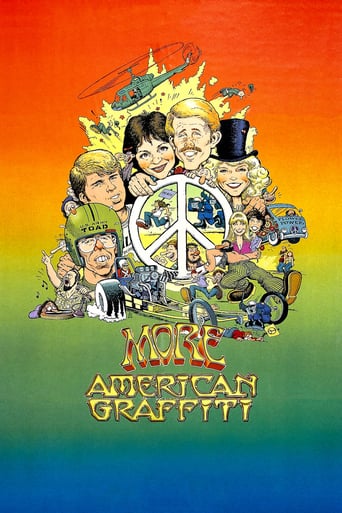

Wow! There have been bad movies and there is this movie and it is just terrible! The attempts to be cute with different photography techniques fall flat. The story is extremely lame. The first movie was great and well done but this one really sucks. It should only be recommended to someone you wish to punish! The primary actors have always been favorites but they really fall flat with this extremely weak script. Ron Howard appears very uncomfortable with his role and is never convincing. But, with a script this bad one can only do so much. The Vietnam sequences are exceptionally strained as well as the remainder of the movie. Watch anything else and you'll likely do better. Best of luck!
... View MoreSome Spoilers After seeing Happy Days, then seeing American Graffitti, I was happy to identify characters, that carried over from the movie to the TV Show. However, you could not really identify the characters in common from More American Graffitti and Happy Days.More American Graffitti does not have the same focus as American Graffitti and the characters, are not in the same stage of their lives.More American Graffitti presents the stories of 4 characters in a more adult stage of their lives on four consecutive New Years Eves, John Milner in drag racing in 1964, Terry Fields in Viet Nam in 1965, Debbie Dunham in San Francisco in 1966, and Steve and Laurie Bolander in Modesto in 1967. Additionally, the music of the sixties is mixed into the movie. The events of that day are not extremely interesting but can keep your interest.One problem with this movie is that we know from the ending of American Graffitti that two of the characters died on the day they are focused on. We keep following those two characters throughout that day, fearing we will see them die. It is like movie about events taking place the morning of November 22, 1963 in Dallas up to 12:29 PM.
... View MoreFurther adventures of the characters from American Graffiti. A lot of people reacted badly to the fact that the first movie was linear, happening in chronological order over one night, while the sequel is spread over 4 years and jumps around from one year to the next, etc. Add the split screen (which is an homage to 60's visual styles) and people got confused and tired of trying to keep track of which story and what period of time was being portrayed. That said, there are some really great scenes in this movie. In particular, I loved the scenes where Laurie (Cindy Williams) goes to the campus protest, gets caught up in it when she wasn't any part of it and has to run for her life (had this happen to me once). Then when her husband Steve (Ron Howard) steals a police van to rescue her, it was a delightful turn of the tables.
... View MoreI loved the first "American Graffiti" with all my heart and soul that I considered it to be the best movie about rock n' roll along with being the best teenager flick I've ever seen. The first film spawned the careers of George Lucas who would later do the blockbuster epic "Star Wars" before doing the prequels two decades later while making Richard Dreyfuss a star in Jaws, Close Encounters of the Third Kind and other films as well.Somehow without those two, the magic died off."More American Graffiti" shows audiences what happened to the rest of the characters later on in the sixties where Steve (Ron Howard) and Laurie (Cindy Williams) are protesting against the Vietnam War while their friend Terry "The Toad" Fields (Charles Martin Smith) is in the war himself and trying to get out. John Milner (Paul Le Mat) is still the hot drag racer in California where he never quite left home. The rest of the supporting actors in the film from Candy Clark's Debbie (Terry's Girlfriend), to the Pharaoh's gang members, along with Harrison Ford and others really don't do much. The original film showed teenagers cruising the streets without any bloodshed with the early music of rock n' roll from Buddy Holly, The Fleetwoods, Chuck Berry, Fats Domino, Bill Haley and the Comets, Buddy Knox and more that brought back the nostalgia bug in classic music. The soundtrack for "More American Graffiti" is a mixture of rock, soul, country, hippie music, and whatever fitted the mood during the late 60's of protesting, drugs, sacrifices and more.After watching "More American Graffiti" it looked like it wanted to show audience members what happened after the title epilogue of the four main characters in the first film (with the exception of Dreyfuss's character) where it wasn't necessary. This film wasn't necessary either as I was glad to see that neither Lucas or Dreyfuss moved on to bigger and better projects.
... View More